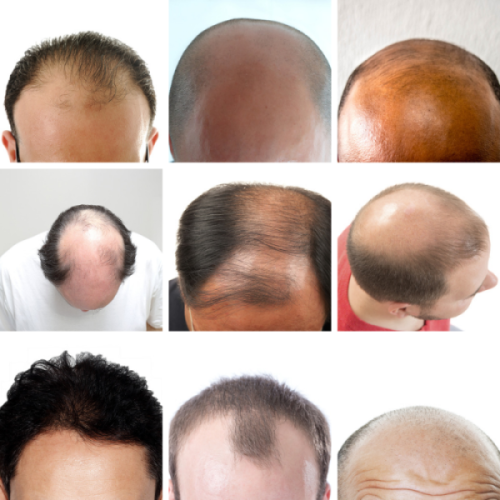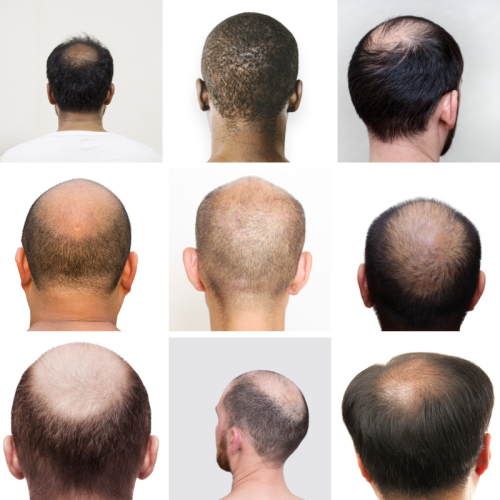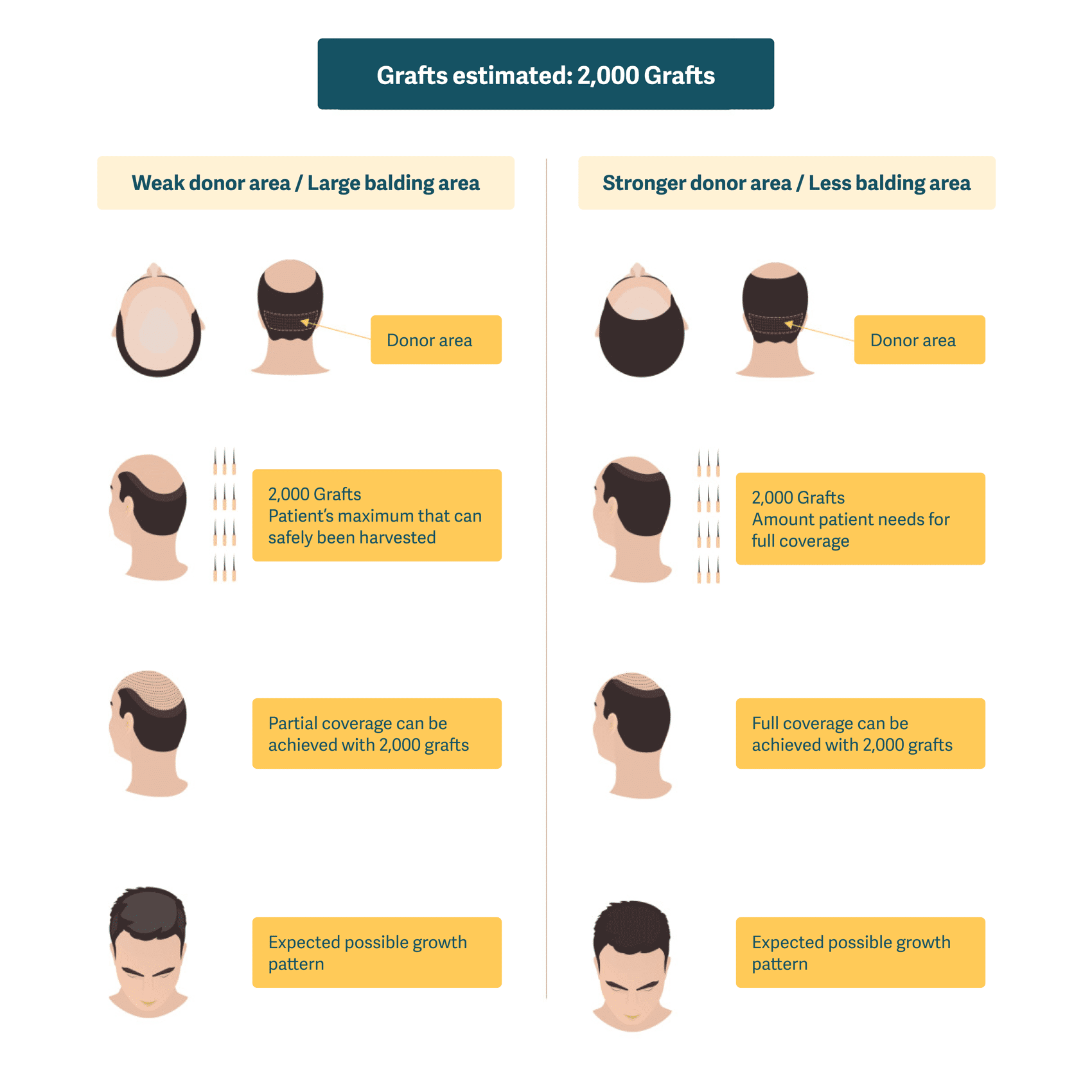Full Hair Transplants: Is Complete Coverage Possible?
You may have already read a lot about getting a full hair transplant and wondered: how much coverage can they actually achieve? Can they completely cover my balding areas with new hair? Or would I need to get a second hair transplant? Unfortunately, the answer to the question of full head hair transplants and complete coverage is slightly anti-climactic: it depends. The dependent factors range from how much hair you have available to be transplanted, your type of hair, any evidence of future hair loss, as well as your own personal expectations for your hair restoration treatment. We’ll look into all of these factors in detail to understand how they contribute to the ability for a full hair transplant to achieve complete coverage. Before we do that though, let’s first take a look at exactly what a hair transplant is and what we mean by complete coverage.
Find the Right Hair Transplant Specialist at a Fraction of the Cost
Qunomedical only lists hair transplant clinics and doctors that have been thoroughly vetted with quality and affordability in mind. Contact us for your 100% free, non-binding assessment.
What Is a Hair Transplant?
When we hear the word 'transplant', initial connotations of liver, kidney, or heart transplants may spring to mind; it’s something that is donated from one person to another. With a hair transplant however, the hair used is your own. So, unfortunately, curly hair can’t be combined with straight hair and your friend’s luscious locks can’t be transplanted onto your head. At least, none of these options are possible yet. Hair transplants don’t just have to be on your head either. Nowadays, treatment options include beard transplants, eyebrow transplants, and even eyelash transplants. There are a few different techniques available too, with follicular unit extraction (FUE) and direct hair implantation (DHI) being the most popular choices. A modern hair transplant simply takes some of the hair you have left — most commonly the back or sides of your head — and moves it to where it has fallen out, usually the top of your head. Hair is not obtained from an outside source or created, rather it’s a redistribution of the hair you currently have on your head. At its simplest, a hair transplant is a matter of supply and demand: How much hair your balding area demands versus how much hair your donor area can safely supply.
What Do We Mean by Complete/Full Coverage?
You may have heard this term used a lot during your research on hair transplants. Simply put, full or complete coverage most often refers to when a high density of hair grafts can be transplanted to the balding areas a patient wishes to cover. When faced with the prospect that complete coverage is not possible, some patients still request that their hair be transplanted to all balding areas. This is a way to cover all balding areas, but the density of the hair in these areas will be low. Most hair specialists tend to advise against this method though, as experience has taught them that this approach tends not to create an aesthetically-pleasing, natural look that the patient will ultimately be happy with. If your donor area — that’s the area where your hair is taken and transplanted from — has a limited amount of available hair and you have a large balding area, most hair transplant doctors will concentrate on transplanting the available hair to the hairline and work back from there. The initial focus on first achieving a good density of hair at the hairline is because this is the angle you see in the mirror or when people meet you. As well as this, hair at the front of your head can be grown longer and styled in certain ways to give the appearance of more fullness on the top and crown, even if there is a lower density of hair in these areas. The appearance of fullness may be aided by other cosmetic products as well. For some, this is sufficient and gives them the feeling of complete coverage. Therefore, it’s important to know specifically what your doctor is referring to when they speak about being able to achieve or not achieve complete coverage. This also helps set your expectations for what a full hair transplant can achieve for you.
How Do I Know If My Full Hair Transplant Will Result in Complete Coverage?
The ability to achieve complete coverage with a full head hair transplant can be dependent on a variety of different factors.
1. How much hair you’ve lost.
Where does your hair loss fall on the Norwood Scale?
Do you just have a receding hairline?
Have you completely lost hair in the front, top, and crown area of your head?
2. How much and what type of hair you have left in your donor area.
Do you only have a narrow strip of hair left around the back of your head?
Or does the hair extend up the sides with balding occurring just on the top or front?
Do you have thick or wavy hair left in your donor area?
Or is it quite thin and not dense?
3. Whether you’re likely to have more hair loss in the future.
How long have you been losing your hair?
Do you have a family history of hair loss that your pattern is likely to follow?
Let’s now take a closer look at some of these points.
How Much Hair You've Lost
The amount of hair that you’ve lost, and the stage that you're at in the Norwood Scale, can help you and your doctor to assess whether complete coverage is a realistic goal for you.
Size of Balding Area
The Norwood Scale is a classification system for measuring the extent of male pattern baldness. In other words, it gives you a general reference for measuring the demand of your balding area. However, keep in mind that the Norwood Scale should just be used as a reference point. For example, you may have hair loss that follows a pattern on the scale but still have some thin hair left in the balding areas. Therefore, your baldness pattern may not quite follow any of the patterns on the Norwood Scale, or alternatively, it could be a combination of a couple of patterns. When researching online and chatting with your doctor about your full hair transplant, you may often hear the term 'grafts per cm²' being used. The extent of your hair loss and the size of your scalp will determine how many cm² need to be covered on your head.

Achieving Density
Natural hair density can vary greatly between individuals with research even showing that average hair density can vary according to ethnicity. Many of us considering a hair transplant dream about getting back to the hair of our youth. Unfortunately, recreating the exact density of natural hair is generally not possible with a full head hair transplant. However, this treatment can still give the appearance of substantial density with proper planning and styling. Someone whose hair loss is at stage six or seven on the Norwood Scale will generally struggle to obtain complete coverage with a full hair transplant because the balding area is so large and a significant amount of hair has already been lost. However, this doesn’t necessarily exclude someone with this level of baldness from having a full hair transplant, provided that realistic expectations are set. Hair restoration surgery may still be able to create a hairline to frame the face and give you a desired look.
Your Donor Area
As previously mentioned above, the type and amount of hair that you have in your donor area can be a decisive factor in obtaining complete coverage.
Where Does Donor Hair Come From?
The donor area is generally a rectangular band extending from ear to ear. It doesn’t include the hair that goes down to your neck as this area usually has less density and the hairs themselves are often thinner or 'miniaturised' and so are not suitable to be transplanted. It also doesn’t include the area within the crown region — the top, back part of your head — as this area is generally not resistant to the hormone dihydrotestosterone (DHT), which is considered to be the hormone that causes hair loss. And this is the most important characteristic about the hairs around the back and sides of your head — they’re resistant to DHT. As the hormone that’s thought to be responsible for male pattern baldness, this explains why the hair in the donor area is retained, while the hair on the top and front of the hair thins and recedes.

Transplants work because when hair from the donor area is transplanted to the balding area, they retain their resistance to DHT. This prevents the transplanted hair from falling out in the future. Body hair transplants (using hair from the chest, beard, and sometimes legs or armpits) have also developed as an alternative option for adding extra donor hair when there is not enough in the scalp area, which helps the result look more full. Hair transplant surgeons don't generally use these as the main source of donor hair however, because these types of body hair often differ in thickness, texture, and colour. They’re more commonly used in combination with the naturally-textured head donor hair to give the most natural looking results.
Does Donor Hair Grow Back?
Unfortunately, donor hair is not able to grow back. This is because the whole hair follicle (containing the hair bulb, dermal papilla, sebaceous cells, dermal fat, and a little skin) is harvested during a transplant. It’s necessary to remove the whole hair follicle in order for the hair to be able to grow again when it’s transplanted into the balding or thinning area. Think of it like replanting a tree — you need to dig up the roots with the tree so it can thrive in another location.
Maintaining Density
Most men have about 8,000–10,000 follicular units (or hair grafts) in their donor area. This begs the question, 'what is the maximum number of hair grafts that can be harvested?' Doctors have varying opinions on this, but it ultimately comes down to how much can be extracted without decreasing the donor area's density so much as to be noticeable, which is why each patient has their own assessment. Estimates range from 35%–50%, so in any case, nowhere near even the lowest of the average available - 8,000 grafts. Hair transplant surgeons will always discuss the possibilities with the patient. Even if harvesting up to 50% of the donor area is possible, that leaves a limit of 4,000–5,000 grafts available for a full hair transplant. As mentioned above, body hair can help 'extend' the donor area but is generally not used as a primary source. Hair loss is also not only genetic but affected by age. So another concern is that as you get older, the density in your donor area will also naturally decrease. If too many grafts are removed for a transplant and your hair density decreases, you may end up with hair that looks very thin or 'moth-eaten' in your donor area. To keep your donor area looking full, and to avoid creating the very bald patches you are trying to eliminate, your doctor will ensure they don’t remove too many grafts. If they harvest too many in an effort to fill balding areas on the top and front, the hair at the back of your head could be left looking thin and possibly with bald patches. All of these factors mean the supply of donor hair available for a full hair transplant will always have a limit.
Is Future Hair Loss Likely?
It’s very difficult to know what the exact extent of your hair loss will be. A family history of hair loss can be a helpful predictor but, because you have genes from both your mother and father, your hair loss may not follow the exact pattern of a relative with hair loss. It’s recommended to have a full hair transplant once you’ve been losing hair for a while and it has begun to stabilize. This is because a hair restoration surgery can replace hair that has already fallen out but it can’t prevent future hair loss. If you go for a full head hair transplant as your hair loss has only just begun and before it has had the chance to stabilize, then even after your treatment, you may still experience the natural progression of the loss of your existing hair. Therefore, it’s also worth bearing in mind that, if this is the case, then you may need a second transplant in the future if you wish to fill in areas where the hair continued to fall out. This will need to be taken into account when planning your hair transplant so the donor area can be preserved enough to supply grafts for another treatment, if needed.
Full Head Hair Transplant Surgery and Achieving Complete Coverage
When determining hair transplant coverage, we can see that multiple factors should be taken into account. These factors take in the past, present, and future state of your hair. All in all, this essentially means that the answer to 'can I achieve full coverage?' is not a simple yes or no. When it comes to your treatment, the number for your hair graft estimate will reflect what is possible for your hair restoration, including how many grafts you need to achieve coverage and what that coverage will be. When choosing a clinic for your treatment though, make sure your graft estimate is clear before undergoing the procedure. Many hair transplant clinics in Turkey for example, state that they can transplant up to 4,500 grafts in one session and some patients expect that is how many grafts will be transplanted for them. However, that number is a general guideline of what can be possible. It’s a maximum and not the average or default amount of grafts. This number will vary depending on your suitability and eligibility for the treatment.

After seeing some clear pictures of your head, it’s likely that your hair transplant specialist will be able to give you an early indication of how much coverage you can expect from your treatment. However, a more accurate evaluation will be able to be made during your initial consultation before surgery. Initial consultations are the time for you and your doctor to discuss expectations and plan your full hair transplant together. That may mean deciding whether to already plan for a second treatment to actively preserve the donor area or transplant what is possible and wait. In either case, it will be necessary to wait a minimum of 8-12 months (depending on your doctor’s advice) to observe how your hair growth progresses after your full hair transplant.
We work with many renowned hair transplant surgeons worldwide, such as Dr. Cinik from the Dr. Cinik Hair Transplant Clinic in Istanbul or Dr. Erdogan from the Smile Hair Clinic, also in Istanbul. Contact us now for your 100% free, non-binding assessment. Our team of Patient Managers are here to help, from initial consultations, to your successful recovery.
Disclaimer
The information in this article is for educational purposes only and does not replace medical advice. Always consult your doctor before starting any treatments.
*The photographs above are for demonstration purposes only and not actual patients of Qunomedical partners.

Patient manager
Frieda
Your personal Patient Manager
Let's talk
Still unsure? Feeling overwhelmed? Talking to a real person can give you the guidance and reassurance needed. You don’t have to do it alone. Let’s find the right doctor together.
